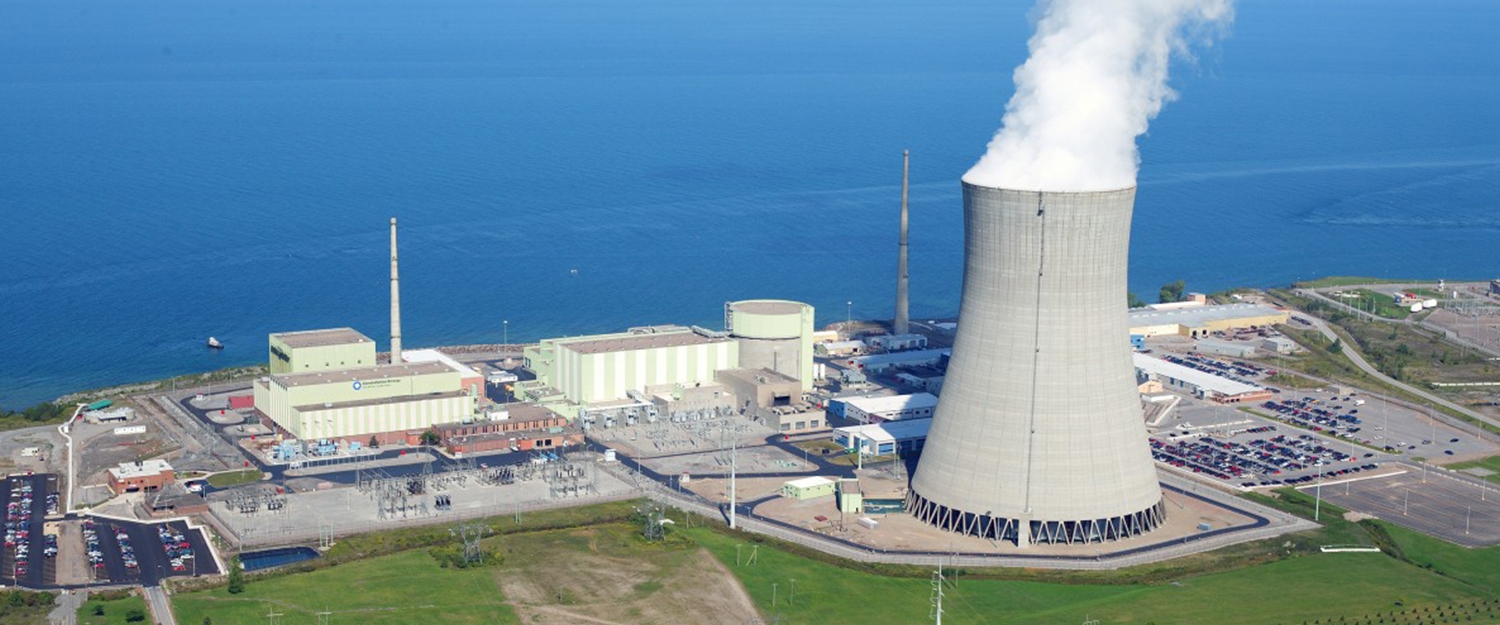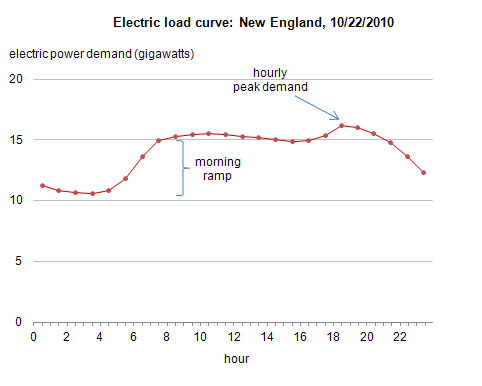Base load Electricity vs. Peak Electricity
I was writing a post about how a coal fired power plant works, and then realized that I needed to describe more about our electrical power grid and how each power component fits into it. Also, speaking of power grids, there is an excellent game called Power Grid that anyone who knows me should come over and play.
Base load electricity!
Pictured above is the electricity demand for an October day in New England. Notice that throughout the middle of the night, the electricity demand is roughly 10GW. Throughout the day it ramps past 15GW. Base load electricity in this case is 10GW. It is the minimum amount of electricity needed at any point. All power plants that provide base load electricity will run 24 hours a day. Base load power plants need to be very reliable so they don’t shut down unexpectedly.
Base load electricity requirements do change throughout the year. During the sweltering summer in southern states, air conditioners are constantly on, drawing more electricity in the summer. In some countries, there is not enough base load electricity to provide electricity in the worst months. In Pakistan, for instance, there will not be viable electricity more than 4 hours per day for several months. We will return to base load electricity soon.
Peak electricity is whatever is above base load. In the above figure, it is the all the extra stuff from 10GW to 15GW. Peaking power presents special challenges, because it can be unpredictable. If the temperature is several degrees warmer in a summer afternoon, the peak electricity requirements can be greater than predicted. Power plants that are capable of ramping up power quickly will compensate for peak electricity demand. “Ramp Rate” is the MW per minute a turbine can spin up at. This ramp rate is important, and we will get back to that almost immediately.
A brief interlude on cost! Base load electricity tends to be pretty cheap. A base load plant will not get paid as much for electricity. Peaking plants are designed to turn on only when electricity is more in demand. This means they get to charge more! A peaking power plant will figuratively not get out of bed in the morning for less than 50% above base load electricity rates.
Okay so here is where things get somewhat more complicated. Some power plants can never be taken offline in short order (think nuclear). Thermal power plants tend to take longer to create enough heat and steam to spin up their turbines, including both coal and nuclear, and some types of natural gas. Anything that takes a long time to spin up is meant for base load power.

A nuclear power plant with the nuclear plant (small rectangle buildings and one cylindrical building) and a cooling tower (big steaming parabolic-shaped tower). Nuclear power plants never shut down, except to change fuel rods.
Other types spin up very quickly. For some, like natural gas plants that are designed to deal only with the peak electricity use, a typical turbine can ramp at a massive 20MW per minute (most plants have several turbines, and can ramp at multiples of 20MW!). Why don’t we use these for base load, since they seem so flexible? These fast-ramping systems are not designed to be always-on. They accrue damage if they do not have downtime.
Let’s talk about renewables. A power plant has to produce either base load or peaking electricity on demand to be useful. We have the magic of hydro electricity. It combines a very high ramp rate, and also capable of maintaining base load electricity. Wind and solar at first seem terrible. They only work when the wind is blowing or when the sun is shining. So they cannot provide either base load or peaking electricity, right? Fortunately, this is not correct. Due to complexities we will discuss in later posts, wind and solar can be installed and paired with each other and with other tech to produce somewhat reliable base load electricity or peak electricity.
One example? When does electricity demand peak in the summer?
If you said when it gets hot and air conditioners work harder and draw more electricity, you are onto something. And it gets hot when the sun shines. Put some solar panels on your roof, and you see your solar panel electricity production rise coinciding with your need for more electricity for house cooling.
Every power plant type has important considerations for peak load vs. base load. As we look at each in turn, it will become apparent how important this distinction is.
One last thing before closing. How do power plants figure out when to turn on? In New England, we have a group called ISO New England. It projects electricity demand based upon yearly trends (people consume a ton of electricity over holidays, and at different time periods!) and upon weather forecasts. Each day, every power plant puts in a bid for how many cents per kilowatt hour they need to turn on. In other words, it’s the figurative “price per kwh to get out of bed.” If demand is projected to rise to such a point that the bid for a plant is met, that plant will turn on once the price hits that. This is confusing. Let’s use an example.
We have three power plants in our imaginary tiny country. Since I keep bringing up this country, I am going to call is JasonLand (for now). JasonLand currently has a coal fired plant, a nuclear plant, and a natural gas plant designed for peaking. The nuclear plant cannot shut down. It will literally bid -$0.50/kwh to ensure that no matter how low the price is, it will produce electricity. Our coal-fired power plant is baseload, but will shut down on days when it is not needed. It will bid $0.07/kwh. As soon as the price rises above this, it will start up (this is simplified, starting a coal power plant takes a long time). Our peaking gas plant will bid in at $0.11/kwh. Once people get home and need more power, or when it is a really hot day, our peaking gas plant will spin up its turbines rapidly.
So how do these bids work? How much does each plant get paid? As demand rises, price rises, and the power plant earns more for every kwh. Our nuclear power plant will make a small amount in the middle of the night, and make more during the daytime. I’ll leave you to ponder why a power plant would choose to not run until a certain payment threshold is hit.
Because I can’t help myself, let’s close with a tiny bit of math. A realistic price for energy in New England is about $0.15/kwh. To make it easy, let’s convert to $150,000/gwh*. A nuclear plant is about 1gw. It will produce 24 gwh of electricity in a day. That is $3,600,000 in revenue per day. Every week it earns nearly $25 million. I hope at this point any regular reader is beginning to get a sense of how staggering numbers associated with energy use are.
Thanks for reading again!
Jason Munster
*Correction: original post was a factor of 10 short.

